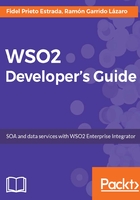
Reader feedback
Feedback from our readers is always welcome. Let us know what you think about this book-what you liked or disliked. Reader feedback is important for us as it helps us develop titles that you will really get the most out of. To send us general feedback, simply e-mail feedback@packtpub.com, and mention the book's title in the subject of your message. If there is a topic that you have expertise in and you are interested in either writing or contributing to a book, see our author guide at www.packtpub.com/authors.
Conventions
In this book, you will find a number of text styles that distinguish between different kinds of information. Here are some examples of these styles and an explanation of their meaning. Code words in the text, database table names, folder names, filenames, file extensions, pathnames, dummy URLs, user input are shown as follows: "Use wum check-update wso2ei-6.0.0 to check for updates".
A block of code is set as follows:
<messageFormattercontentType="application/json" class="org.wso2.carbon.integrator.core.json.JsonStreamFormatter"/> <messageBuildercontentType="application/json" class="org.wso2.carbon.integrator.core.json.JsonStreamBuilder"/>
When we wish to draw your attention to a particular part of a code block, the relevant lines or items are set in bold:
wumconfiglocal.product.repo wso2/products
New product repository is \wso2\products
New terms and important words are shown in bold. Words that you see on the screen, for example, in menus or dialog boxes, appear in the text like this: "In the WSO2EI Tooling top menu, click on Run | Debug Configurations."